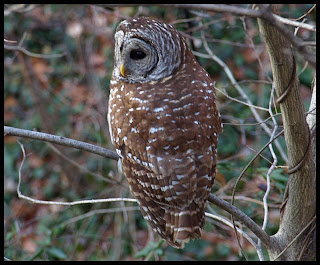Thursday, Mar 6th:
10:00 AM, Temperature: 4 C (40F)
Observed both the Red-shouldered hawks from 9:15 am onwards. One of the birds was perched high up on the dead tree behind (south of) Olin Hall while the other bird seemed to be hunting, flying around the area, sometimes soaring briefly. The perched bird appeared pale, with slight horizontal barring on its underside. I had noticed earlier (Mar 4th) that the hawk involved in the conflict with the owl was very vibrant, with rich colors and some dark, brown streaks extending from underneath the chin to the upper parts of its golden-brown breast. If this is truly a distinguishing feature between the two birds I will most likely be able to identify the male from the female. When I’d watched the two mating (Feb 28th), I had only noticed the apparent size difference and had not been able to tell them apart based on plumage. So, I looked again at the short video taken that day and could pick out the streaking on one of the birds. If my observations of the day are correct, I can say with some certainty that the bird with the streaks on her breast is the female and the pale breasted, slightly smaller bird the male!
(I’ve now decided to give the pair names. The female with her cinnamon-streaked breast will henceforth be referred to as Cinnamon, and the male as Jasper. You can clearly see the rich colors and dark streaks on Cinnamon photographed on Mar 2nd.)
Both birds then called to each other and Cinnamon landed next to Jasper. With both birds facing me, I could through my binoculars, clearly see the difference between the two. The pair spent around 15 minutes at this perch and then took off over Olin Hall and found a new perch in the beech by the pond (where I’d seen them mate). I could now see them from my office window. Here they stayed enjoying the warmth of the sun until 11:00 am, while I wrote down my observations in my journal. I kept one eye out to see if they would mate again giving me confirmation of my gender identification.
11:20 AM, the day was warming up (7 C, 45 F). The pair moved to a lower branch from where they had a commanding view of the pond below. I decided to video shoot and in a few minutes Jasper dived straight down from his perch and caught a small rodent near the edge of the water. For a few moments he was in the water itself! He then flew up to one of the tangles growing along the edge, completed his meal and made that his new perch. Cinnamon, not having much success here, flew off towards the nest.
Why do Jasper and Cinnamon have different plumage?
The Red-shouldered hawk (Buteo lineatus) is divided into five subspecies – lineatus (widespread, eastern race), alleni (southeastern), extimus (southern Florida), texanus (Texas – surprised?), and elegans (California)1. Of these, the subspecies alleni ‘usually lacks breast streaking’1 and is also ‘slightly paler’2. B. l. lineatus is known to breed in eastern North America from Texas through Canada, whereas B. l. alleni is a known resident in the southeast from Texas through Florida and South Carolina3.
 Jasper and Cinnamon together facing opposite directions - Cinnamon keeps an eye on me (top); Jasper keeps watch (above).
Jasper and Cinnamon together facing opposite directions - Cinnamon keeps an eye on me (top); Jasper keeps watch (above).
Jasper and Cinnamon seem to show enough plumage differences (pale vs. streaked) to suggest the possibility that Cinnamon belongs to the more widespread lineatus subspecies and Jasper comes from the southeastern alleni subspecies. Indeed, there is some evidence for the eastern subspecies to overlap each other’s range and thus come into contact with one another4.
On the other hand, this may just be a case of significant variation within B. l. lineatus. To clearly make a subspecies distinction between this pair with my limited experience would be foolish. Nonetheless, the distinctive plumages of Jasper and Cinnamon, certainly make it easier to identify each of them separately!
(If any of you out there can confirm/refute a subspecies distinction between Jasper and Cinnamon, please let me know!)
1 Field guide to the birds of North America, 4th Edition, National Geographic Society.
2 http://animaldiversity.ummz.umich.edu/site/accounts/information/Buteo_lineatus.html
3 Johnsgard, Paul A. (1990) – Hawks, Eagles & Falcons of North America. Smithsonian.
4 http://www.birds.cornell.edu/AllAboutBirds/BirdGuide/Red-shouldered_Hawk.html
 Jasper and Cinnamon have been busy enlarging the nest in the past 3 weeks.
Jasper and Cinnamon have been busy enlarging the nest in the past 3 weeks. Jasper (left) pauses before taking off on another hunt, while Cinnamon (right) is ready to resume incubation.
Jasper (left) pauses before taking off on another hunt, while Cinnamon (right) is ready to resume incubation. 





















.jpg)